American Airlines
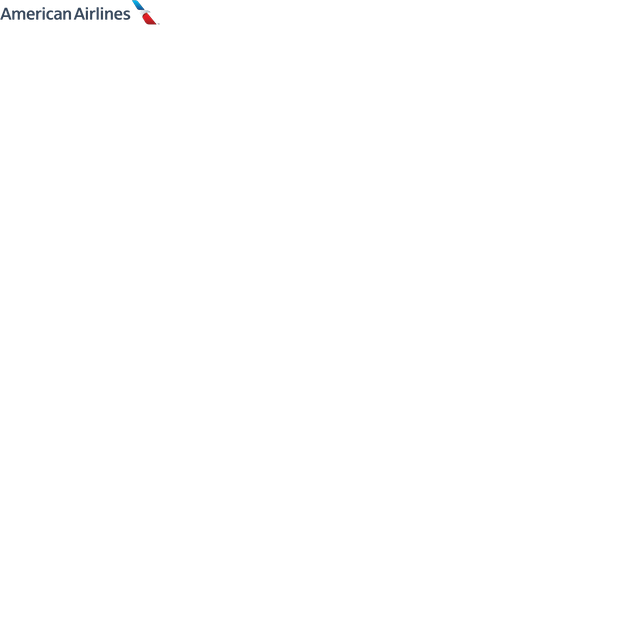
American Airlines

| |||||||
| Founded | April 15, 1926 (1926-04-15)(earliest predecessor airline as American Airways, Inc.) Chicago, Illinois, United States[3] | ||||||
|---|---|---|---|---|---|---|---|
| Commenced operations | June 25, 1936 (1936-06-25)[3] | ||||||
| AOC # | AALA025A[4] | ||||||
| Hubs |
| ||||||
| Frequent-flyer program | AAdvantage | ||||||
| Alliance | Oneworld | ||||||
| Fleet size | 941 (mainline)[5] | ||||||
| Destinations | 350[6] | ||||||
| Company slogan | "Great is what we're going for" | ||||||
| Parent company | American Airlines Group | ||||||
| Traded as | NASDAQ: AAL [124] | ||||||
| Headquarters | Fort Worth, Texas, United States | ||||||
| Key people | •Doug Parker (Chairman & CEO) •Robert Isom (President) •Elise Eberwein (Executive Vice President - People and Communications) •Stephen Johnson (Executive Vice President - (Corporate Affairs) •Derek Kerr (Executive Vice President and CFO) •Maya Leibman (Executive Vice President and Chief Information Officer) •[7] | ||||||
| Revenue | See parent | ||||||
| Operating income | See parent | ||||||
| Net income | See parent | ||||||
| Total assets | See parent | ||||||
| Total equity | See parent | ||||||
| Employees | 126,600 (Jun 2018) | ||||||
| Website | www.aa.com [125] | ||||||
American Airlines, Inc. (AA) is a major American airline headquartered in Fort Worth, Texas, within the Dallas–Fort Worth metroplex. It is the world's largest airline when measured by fleet size, revenue, scheduled passengers carried, scheduled passenger-kilometers flown, and number of destinations served. American, together with its regional partners, operates an extensive international and domestic network with almost 6,800 flights per day to nearly 350 destinations in more than 50 countries.[8] American Airlines is a founding member of Oneworld alliance, the third largest airline alliance in the world. Regional service is operated by independent and subsidiary carriers under the brand name American Eagle.[9]
American Airlines and American Eagle operates out of 10 hubs, with Dallas/Fort Worth being its largest; handling more than 200 million passengers annually with an average of more than 500,000 passengers daily. American operates its primary maintenance base in Tulsa in addition to the maintenance locations at its hubs. As of 2019, the company employs nearly 130,000 people.[10] Through the airline's parent company, American Airlines Group, it is publicly traded under NASDAQ: AAL with a market capitalization of about $12.7 billion as of 2019, and included in the S&P 500 index.[8]
| |||||||
| Founded | April 15, 1926 (1926-04-15)(earliest predecessor airline as American Airways, Inc.) Chicago, Illinois, United States[3] | ||||||
|---|---|---|---|---|---|---|---|
| Commenced operations | June 25, 1936 (1936-06-25)[3] | ||||||
| AOC # | AALA025A[4] | ||||||
| Hubs |
| ||||||
| Frequent-flyer program | AAdvantage | ||||||
| Alliance | Oneworld | ||||||
| Fleet size | 941 (mainline)[5] | ||||||
| Destinations | 350[6] | ||||||
| Company slogan | "Great is what we're going for" | ||||||
| Parent company | American Airlines Group | ||||||
| Traded as | NASDAQ: AAL [124] | ||||||
| Headquarters | Fort Worth, Texas, United States | ||||||
| Key people | •Doug Parker (Chairman & CEO) •Robert Isom (President) •Elise Eberwein (Executive Vice President - People and Communications) •Stephen Johnson (Executive Vice President - (Corporate Affairs) •Derek Kerr (Executive Vice President and CFO) •Maya Leibman (Executive Vice President and Chief Information Officer) •[7] | ||||||
| Revenue | See parent | ||||||
| Operating income | See parent | ||||||
| Net income | See parent | ||||||
| Total assets | See parent | ||||||
| Total equity | See parent | ||||||
| Employees | 126,600 (Jun 2018) | ||||||
| Website | www.aa.com [125] | ||||||
History
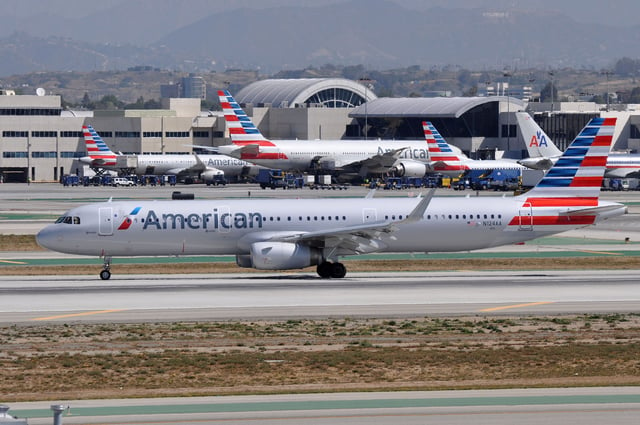
American Airlines Airbus A321 at Los Angeles International Airport in 2015

DC-3 cabin
American Airlines was started in 1930 via a union of more than eighty small airlines.[11]
The two organizations from which American Airlines was originated were Robertson Aircraft Corporation and Colonial Air Transport. The former was first created in Missouri in 1921, with both being merged in 1929 into holding company The Aviation Corporation. This in turn, was made in 1930 into an operating company and rebranded as American Airways. In 1934, when new laws and attrition of mail contracts forced many airlines to reorganize, the corporation redid its routes into a connected system, and was renamed American Airlines. Between 1970 and 2000, the company grew into being an international carrier, purchasing Trans World Airlines in 2001.
American had a direct role in the development of the DC-3, which resulted from a marathon telephone call from American Airlines CEO C. R. Smith to Donald Douglas, when Smith persuaded a reluctant Douglas to design a sleeper aircraft based on the DC-2 to replace American's Curtiss Condor II biplanes. (The existing DC-2's cabin was 66 inches (1.7 m) wide, too narrow for side-by-side berths.) Douglas agreed to go ahead with development only after Smith informed him of American's intention to purchase 20 aircraft. The prototype DST (Douglas Sleeper Transport) first flew on December 17, 1935, (the 32nd anniversary of the Wright Brothers' flight at Kitty Hawk). Its cabin was 92 in (2.3 m) wide, and a version with 21 seats instead of the 14–16 sleeping berths of the DST was given the designation DC-3. There was no prototype DC-3; the first DC-3 built followed seven DSTs off the production line and was delivered to American Airlines.[12] American Airlines inaugurated passenger service on June 26, 1936, with simultaneous flights from Newark, New Jersey and Chicago, Illinois.[13]
In 2011, due to a downturn in the airline industry, American Airlines' parent company AMR Corporation filed for bankruptcy protection. In 2013, American Airlines merged with US Airways but kept the American Airlines name, as it was the better recognized brand internationally; the combination of the two airlines resulted in the creation of the largest airline in the United States, and ultimately the world.[14]
Destinations and hubs
Destinations
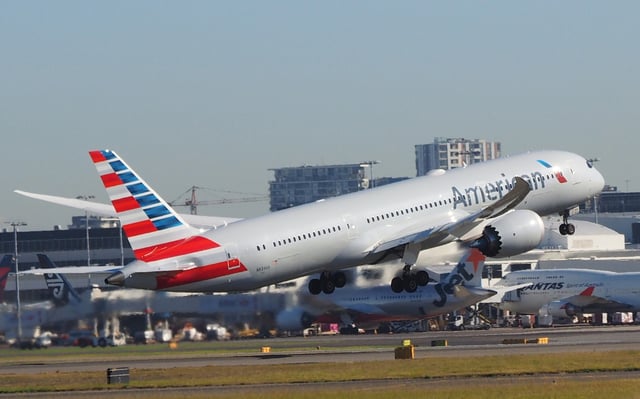
An American Airlines Boeing 787-9 taking off from Sydney Airport in July 2018

American Airlines aircraft at Phoenix Sky Harbor International Airport.
As of July 2019, American Airlines flies to 95 domestic destinations and 95 international destinations in 55 countries in five continents.[15]
Hubs

Map of American Airlines hubs
American currently operates ten hubs.[16]
Charlotte – American's hub for the Southeast.[17] About 42 million passengers fly through CLT on American every year, or about 115,000 people per day.[17] American has about 91% of the market share at CLT, making it the airport's largest airline.[17]
Chicago–O'Hare – American's hub for the Midwest.[18] About 28 million passengers fly on American through O'Hare every year, or about 77,000 people per day.[18] American has about 35% of the market share at O'Hare, making it the airport's second-largest airline after United.[18]
Dallas/Fort Worth – American's hub for the South.[19] American currently has about 84% of the market share and flies approximately 57 million passengers through DFW every year, which is about 156,000 people per day, making it the busiest airline at the airport.[19] American's corporate headquarters are also in Fort Worth near the airport.[19] DFW serves as American's primary gateway to Mexico, and secondary gateway to Latin America.[19]
Los Angeles – American's hub for the West Coast and its transpacific gateway.[20] About 16.5 million passengers fly through LAX on American every year, or about 45,000 people per day.[20] American has about 19% of the market share at LAX, making it the largest carrier at the airport.[20]
Miami – American's primary Latin American hub.[21] About 30 million passengers fly through MIA every year on American, which is about 79,000 people per day.[21] American has about 68% of the market share at Miami International, making it the largest airline at the airport.[21]
New York–JFK – American's secondary transatlantic hub.[22] About 7 million passengers fly through JFK on American every year, or about 19,000 people per day.[22] American has about 12% of the market share at JFK, making it the third-largest carrier at the airport behind Delta and JetBlue.[22] Since 2017, American has been reducing its international operations at JFK, opting to expand its Philadelphia hub instead.[23][24] JFK also serves as a major connecting point for other Oneworld carriers.
New York–LaGuardia – American's second New York hub.[25] About 8.5 million passengers fly through LGA on American every year, or about 23,000 people per day.[25] The airport also serves as a base for American Airlines Shuttle. American has about 27% of the market share at LGA, and is the second-largest carrier behind Delta.[25]
Philadelphia – American's primary transatlantic hub.[26] American flies approximately 20.5 million passengers a year through PHL, which is about 56,000 people per day.[26] American has about 70% of the market share at PHL, making it the airport's largest airline.[26]
Phoenix–Sky Harbor – American's western hub.[27] American flies approximately 20 million passengers a year through PHX, which is about 55,000 people per day.[27] Currently American has about 46% of the market share at PHX, making it the airport's largest airline.[27]
Washington–National – American's hub for the capital of the United States. The airport also serves as a base for American Airlines Shuttle.[28] About 12 million passengers fly through DCA on American every year, or about 33,000 people per day.[28] American has about 49% of the market share at DCA, making it the largest carrier at the airport.[28]
Alliance and codeshare agreements
American Airlines is a member of the Oneworld alliance and has codeshares with the following airlines:[29]
Air Tahiti Nui
Alaska Airlines
British Airways
Cape Air
Caribbean Airlines
Cathay Dragon[30]
Cathay Pacific
China Southern Airlines
Fiji Airways
Finnair[31]
Hainan Airlines
Hawaiian Airlines
Iberia
Interjet
Jetstar Airways
Jetstar Japan
Korean Air[32]
LATAM Argentina
LATAM Brasil
LATAM Chile
LATAM Ecuador
Malaysia Airlines
Qantas
Royal Jordanian
Seaborne Airlines
SriLankan Airlines
Joint ventures
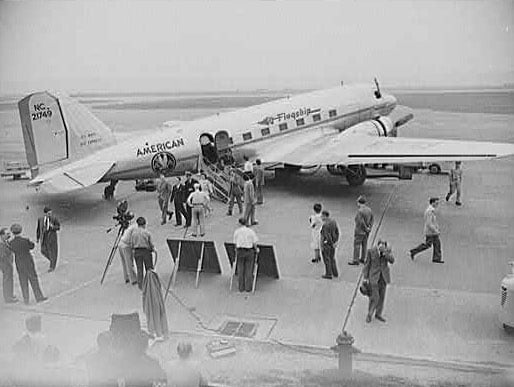
American DC-3 used in a 1943 war film
British Airways
Finnair
Iberia
Qantas
Fleet
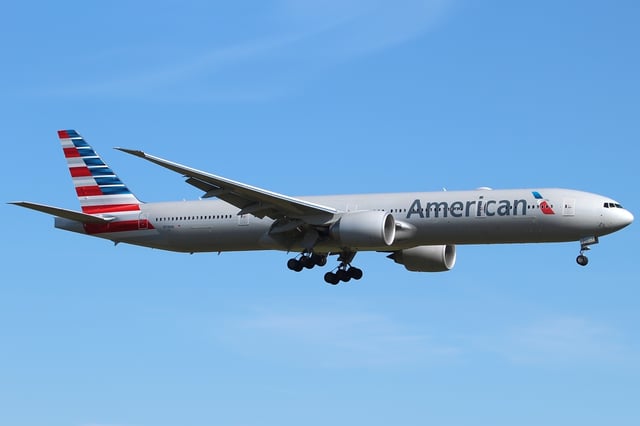
American Airlines Boeing 777-300ER landing at London Heathrow Airport in 2013.
On April 6, 2018, adding to its previous order for 42, American has ordered an additional 47 Boeing 787 which includes 22 787-8 and 25 787-9, for over $12 billion at list prices.[39]
As of September 4, 2019, American Airlines operates a fleet of 940 aircraft, making it the largest commercial fleet in the world. It primarily operates a mix of Airbus and Boeing planes, with an assortment of Embraer aircraft.[5]
Over two thirds of American's aircraft are narrow-bodies, mainly Airbus A320 series and Boeing 737-800s. It also operates Boeing 757s and Embraer 190s, but most of them are planned to be retired by the early 2020s as they are being replaced by the Boeing 737 MAX 8 and Airbus A321neo.[5]
Its wide-body aircraft are mainly Boeing airliners. It is the third-largest operator of the Boeing 767 series and the fifth-largest operator of the Boeing 777 series. It also operates Airbus A330s inherited from US Airways.[42]
Cabins
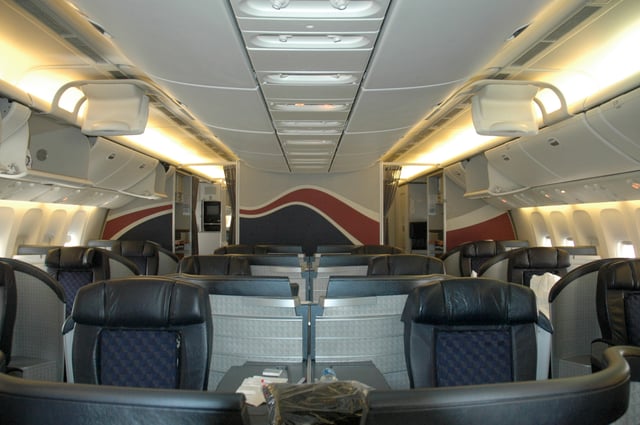
Former First class on American Airlines 777-200 at Dallas/Fort Worth Airport, 2013
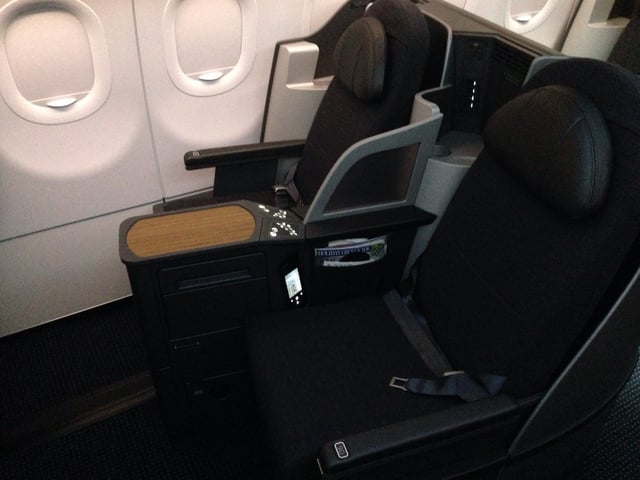
First and business class seats on an A321 Transcontinental (top and bottom, respectively)
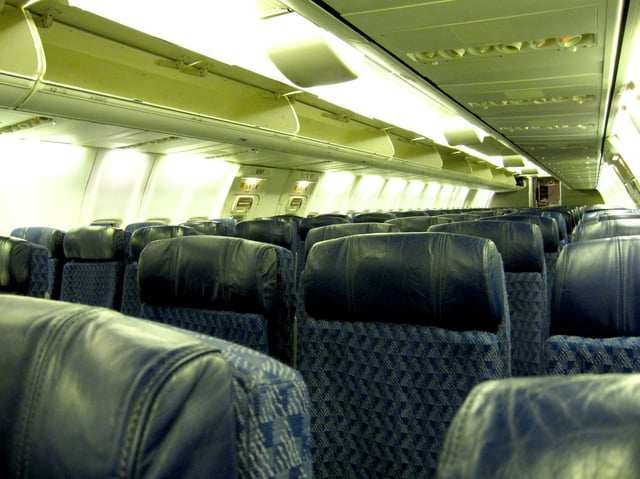
American Airlines Boeing 737-800 economy class cabin on an international flight YUL-MIA in April 2010
- Flagship First
Flagship First is American's international first class product. It is only offered on the Boeing 777-300ERs in the fleet. The seats are fully lie-flat and offer direct aisle access in a 1-2-1 reverse herringbone configuration. As with the airline's other premium cabins, Flagship First offers wider food and beverage options, larger seats, and more amenities at certain airports, e.g., lounge access.
- Flagship Business
Flagship Business is a premium cabin offered on some Boeing 757-200s and all Airbus A330-200s, Airbus A330-300s, Boeing 767-300ERs, Boeing 777-200ERs, Boeing 777-300ERs, Boeing 787-8s, and Boeing 787-9s. All Flagship Business seats are fully lie-flat.[43] Only the Boeing 757-200 does not offer direct aisle access from each seat.
- Transcontinental
American has dedicated 17 Airbus A321s (A321T) in its fleet for the specific use of flying transcontinental routes between New York JFK – Los Angeles, New York JFK – San Francisco and Boston - Los Angeles.These aircraft offer two premium cabins, Flagship First and Flagship Business, which are unique among domestic mainline aircraft in American's fleet. Both cabins feature lie-flat seats; Flagship First also includes direct aisle access from each seat.
- Domestic First Class
First Class is offered on all domestic mainline aircraft, as well as regional aircraft with more than 50 seats. When such aircraft are used on flights to international destinations including Canada, Mexico, Central America, and the Caribbean, the First Class cabin is branded as Business Class. Seats range from 19–21 inches (48–53 cm) in width and have 37–42 inches (94–107 cm) of pitch.[44] Dining options include free snacks, beverages, and alcohol on all flights, with three-course meals offered on flights 900 miles (1,400 km) or longer (some routes under 900 miles also offer meal service).[45]
- Premium Economy
On December 9, 2015, American announced a new Premium Economy cabin for most long-haul widebody aircraft. The cabin debuted on the airline's Boeing 787-9s in late 2016 and is also available on Boeing 777-200s and -300s, some Boeing 787-8s, and Airbus A330-200s. Premium Economy seats are wider than seats in Main Cabin (American's economy cabin) and provide more amenities: Premium Economy customers get two free checked bags, priority boarding, and enhanced food and drink service including free alcohol. This product made American Airlines the first U.S. carrier to offer a four-cabin aircraft.[46]
- Main Cabin Extra
American's economy plus product (not to be confused with premium economy), Main Cabin Extra, is available on most of the mainline fleet and American Eagle regional aircraft with more than 50 seats. Main Cabin Extra seats include greater pitch than is available in Main Cabin,[44] along with free alcoholic beverages.[47] American retained Main Cabin Extra when the new Premium Economy product entered service in late 2016.[46]
- Main Cabin
Main Cabin is American's economy product, and is found on all mainline and regional aircraft in its fleet. Seats range from 17–18.5 inches (43–47 cm) in width and have 30–32 inches (76–81 cm) of pitch.[48]
American Airlines marketed increased legroom in economy class as "More Room Throughout Coach", also referred to as "MRTC", starting in February 2000.[49] Two rows of economy class seats were removed on Boeing 737 and McDonnell Douglas MD-80 aircraft.[50] Amid financial losses, this scheme was discontinued in 2004.[50][51]
On some routes, American also offers Basic Economy, the airline's lowest main cabin fare. Basic economy is located in main cabin, but comes with restrictions. These restrictions include waiting until check-in for a seat assignment, no upgrades or refunds, and boarding in the last group.[52]
In May 2017, American announced it would be adding more seats to some of its Boeing 737 MAX jetliners and reducing overall legroom in the basic economy class. The last three rows will lose 2 inches (5.1 cm), going from the current 31 inches (79 cm) to 29 inches (74 cm). The remainder of the economy cabin will have 30 inches (76 cm) of legroom.[53]
Cabin fume events
In 1988, on American Airlines Flight 132's approach into Nashville, flight attendants notified the cockpit that there was smoke in the cabin. The flight crew in the cockpit ignored the warning, as on a prior flight, a fume event had occurred due to a problem with the auxiliary power unit. However, the smoke on Flight 132 was actually caused by improperly packaged hazardous materials. According to the National Transportation Safety Board inquiry into the incident, the cockpit crew persistently refused to acknowledge that there was a serious threat to the aircraft or the passengers, even after they were told that floor was becoming soft and passengers had to be reseated. As a result, the aircraft was not evacuated immediately on landing, exposing the crew and passengers to the threat of smoke and fire longer than necessary.[54][55]
On April 11, 2007, toxic smoke and oil fumes leaked into the aircraft cabin as American Airlines Flight 843 taxied to the gate. A flight attendant who was present in the cabin subsequently filed a lawsuit against Boeing, stating that she was diagnosed with neurotoxic disorder due to her exposure to the fumes, which caused her to experience memory loss, tremors, and severe headaches. She reached a settlement with the company in 2011.[56]
In 2009, Mike Holland, deputy chairman for radiation and environmental issues at the Allied Pilots Association and an American Airlines pilot, said that the pilot union had started alerting pilots of the danger of contaminated bleed air, including contacting crew members that the union thinks were exposed to contamination based on maintenance records and pilot logs.[57]
In a January 2017 incident on American Airlines Flight 1896, seven flight attendants were hospitalized after a strange odor was detected in the cabin. The Airbus A330 involved subsequently underwent a "thorough maintenance inspection," having been involved in three fume events in three months.[58][59]
In August 2018, American Airlines flight attendants picketed in front of the Fort Worth company headquarters over a change in sick day policy, complaining that exposure to ill passengers, toxic uniforms, toxic cabin air, radiation exposure, and other issues were causing them to be sick.[60][61]
In January 2019, two pilots and three flight attendants on Flight 1897 from Philadelphia to Fort Lauderdale were hospitalized following complaints of a strange odor.[62][63]
Discrimination
On October 24, 2017, the NAACP issued a travel advisory for American Airlines urging African Americans to "exercise caution" when traveling with the airline. The NAACP issued the advisory after four incidents. In one incident, a black woman was moved from first class to coach while her white traveling companion was allowed to remain in first class. In another incident, a black man was forced to give up his seats after being confronted by two unruly white passengers.[64] According to the NAACP, while they did receive complaints on other airlines, most of their complaints in the year prior to their advisory were on American.[65] In July 2018, the NAACP lifted their travel advisory saying that American has made improvements to mitigate discrimination and unsafe treatment of African Americans.[66]
Reward programs
AAdvantage
AAdvantage is the frequent flyer program for American Airlines. It was launched on May 1, 1981, and it remains the largest frequent flyer program with over 67 million members as of 2011. Miles accumulated in the program allow members to redeem tickets, upgrade service class, or obtain free or discounted car rentals, hotel stays, merchandise, or other products and services through partners. The most active members, based on the amount and price of travel booked, are designated AAdvantage Gold, AAdvantage Platinum, AAdvantage Platinum Pro, and AAdvantage Executive Platinum elite members, with privileges such as separate check-in, priority upgrade and standby processing, or free upgrades. They also receive similar privileges from AA's partner airlines, particularly those in oneworld.[67]
AAdvantage co-branded credit cards are also available and offer other benefits. The cards are issued by CitiCards, a subsidiary of Citigroup, and Barclaycard in the United States, by MBNA in the United Kingdom, by Butterfield Bank and Scotiabank in the Caribbean, and by Banco Santander in Brazil.
AAdvantage allows one-way redemption, starting at 5,000 miles.[68]
Admirals Club
The Admirals Club was conceived by AA president C.R. Smith as a marketing promotion shortly after he was made an honorary Texas Ranger. Inspired by the Kentucky colonels and other honorary title designations, Smith decided to make particularly valued passengers "admirals" of the "Flagship fleet" (AA called its aircraft "Flagships" at the time).[69] The list of Admirals included many celebrities, politicians, and other VIPs, as well as more "ordinary" customers who had been particularly loyal to the airline.
There was no physical Admirals Club until shortly after the opening of LaGuardia Airport. During the airport's construction, New York Mayor Fiorello LaGuardia had an upper-level lounge set aside for press conferences and business meetings. At one such press conference, he noted that the entire terminal was being offered for lease to airline tenants; after a reporter asked whether the lounge would be leased as well, LaGuardia replied that it would, and a vice president of AA immediately offered to lease the premises. The airline then procured a liquor license and began operating the lounge as the "Admirals Club" in 1939.
The second Admirals Club opened at Washington National Airport. Because it was illegal to sell alcohol in Virginia at the time, the club contained refrigerators for the use of its members, so they could store their own liquor at the airport. For many years, membership in the Admirals Club (and most other airline lounges) was by the airline's invitation. After a passenger sued for discrimination,[70] the Club (and most other airline lounges) switched to a paid membership program.
Flagship Lounge
Though affiliated with the Admirals Club and staffed by many of the same employees, the Flagship Lounge is a separate lounge specifically designed for customers flying in First Class and Business Class on international flights and transcontinental domestic flights, as well as AAdvantage Concierge Key, Executive Platinum, Platinum Pro, and Platinum, as well as Oneworld Emerald and Sapphire frequent flyers. As of May 2019, Flagship Lounges are located at five airports: New York-JFK.[71] Chicago-O'Hare,[72] Miami International,[73] Los Angeles,[74] and Dallas/Fort Worth.[75] Flagship Lounges are planned for London-Heathrow and Philadelphia.[71]
Lifetime Flight pass
As a means of creating revenue in a period of loss making, American Airlines offered a lifetime pass of unlimited travel, for the initial cost of $250K. This entitled the passholder to fly anywhere in the world. 28 were sold. However, after some time, the airline realised they were making losses on the tickets, with the ticketholders costing up to 1 million each. Ticketholders were booking large amounts of flights, and some ticketholders flying interstate for lunch, or flying to London multiple times a month. AA raised the cost of the lifetime pass, and then finalling stopped offering it in 2003. AA then used litigation to cancel two of the lifetime offers.[76]
Corporate affairs
Headquarters
American Airlines is headquartered in Fort Worth, Texas, adjacent to the Dallas/Fort Worth International Airport.[77] The headquarters is located in two office buildings in the CentrePort office complex and these buildings together have about 1,400,000 square feet (130,000 m2) of space. As of 2014 over 4,300 employees work at this complex.[78]
Before it was headquartered in Texas, American Airlines was headquartered at 633 Third Avenue in the Murray Hill area of Midtown Manhattan, New York City.[79][80] In 1979, American moved its headquarters to a site at Dallas/Fort Worth International Airport, which affected up to 1,300 jobs. Mayor of New York City Ed Koch described the move as a "betrayal" of New York City.[81] American moved to two leased office buildings in Grand Prairie, Texas.[82] On January 17, 1983, the airline finished moving into a $150 million ($377,000,000 when adjusted for inflation), 550,000-square-foot (51,000 m2) facility in Fort Worth; $147 million (about $370,000,000 when adjusted for inflation) in Dallas/Fort Worth International Airport bonds financed the headquarters. The airline began leasing the facility from the airport, which owns the facility.[82] Following the merger of US Airways and American Airlines, US Airways consolidated the corporate headquarters of the new company in Fort Worth, leaving their current headquarters in Phoenix, AZ, which had also been the headquarters of the airline that brought US Airways out of bankruptcy, America West Airlines.
As of 2015, American Airlines is the corporation with the largest presence in Fort Worth.[83]
It will be located on a 41-acre (17 ha) property adjacent to the airline's flight academy and conference and training center, west of Texas State Highway 360, 2 miles (3.2 km)[84] west from the current headquarters. The airline will lease a total of 300 acres (120 ha) from Dallas-Fort Worth International Airport and this area will include the headquarters.[83] Construction of the new headquarters began after the demolition of the Sabre facility, previously on the site.[84]
The airline considered developing a new headquarters in Irving, Texas on the old Texas Stadium site, before deciding to keep the headquarters in Fort Worth.[83]
Branding

American Airlines' fourth logo, used from 1967 to January 16, 2013
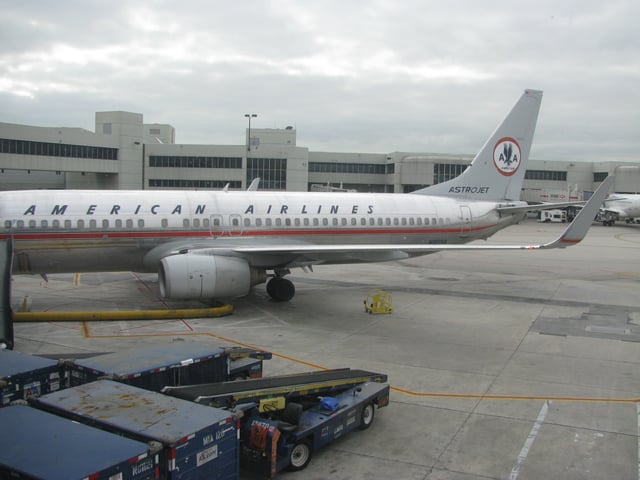
A Boeing 737 in the Astrojet livery
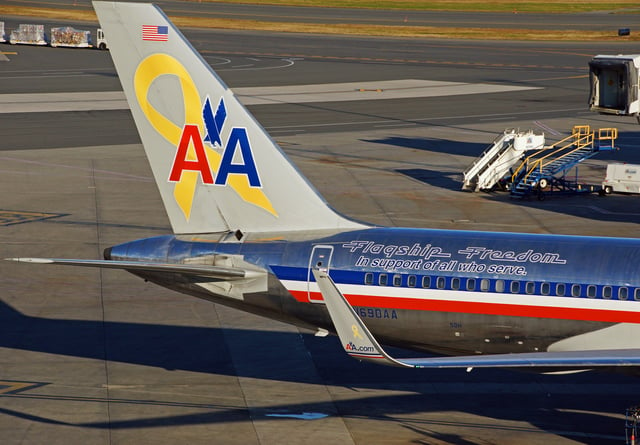
AA "Flagship Freedom" Boeing 757-200, labeled with a "yellow awareness ribbon" symbol, representing support of the United States Armed Forces overseas operations.

Airbus A319 of US Airways wearing Carolina Panthers livery
In 1931, Goodrich Murphy, an American employee, designed the AA logo.[85] The logo was redesigned by Massimo Vignelli in 1967.[86][87] Thirty years later, in 1997, American Airlines was able to make its logo Internet-compatible by buying the domain AA.com. AA is also American's two-letter IATA airline designator.[88]
On January 17, 2013, American launched a new rebranding and marketing campaign with FutureBrand dubbed, "A New American". This included a new logo replacing the logo used since 1967. American Airlines calls the new logo the "Flight Symbol, incorporating the eagle, star, and the letter “A” of the classic logo.[89]
American Airlines faced difficulty obtaining copyright registration for their 2013 logo. On June 3, 2016, American Airlines sought to register their 2013 logo with the United States Copyright Office.[90] In October of that year, the Copyright Office ruled that the logo was ineligible for copyright protection, as it did not pass the threshold of originality, and was thus in the public domain.[90] American requested that the Copyright Office reconsider, but on January 8, 2018, the Copyright Office affirmed its initial determination.[90][91] After American Airlines submitted additional materials, the Copyright Office reversed its decision on December 7, 2018, and ruled that the logo contained enough creativity to merit copyright protection.[92]
American's early liveries varied widely, but a common livery was adopted in the 1930s, featuring an eagle painted on the fuselage.[93] The eagle became a symbol of the company and inspired the name of American Eagle Airlines. Propeller aircraft featured an international orange lightning bolt running down the length of the fuselage, which was replaced by a simpler orange stripe with the introduction of jets.
In the late 1960s, American commissioned designer Massimo Vignelli to develop a new livery. The original design called for a red, white, and blue stripe on the fuselage, and a simple "AA" logo, without an eagle, on the tail; instead, Vignelli created a highly stylized eagle, which remained the company's logo until January 16, 2013. In 1999, American painted a new Boeing 757 (N679AN) in its 1959 international orange livery. One Boeing 777 and one Boeing 757 were painted in standard livery with a pink ribbon on the sides and on the tail, in support of Susan G. Komen for the Cure. One Boeing 757 is painted with a yellow ribbon on the tailfin on the aircraft and on the side of the body says "Flagship Freedom". American Eagle, the airline's regional airline has the same special livery on ERJ-145 aircraft.
On January 17, 2013, American unveiled a new livery.[94] Before then, American had been the only major U.S. airline to leave most of its aircraft surfaces unpainted. This was because C. R. Smith would not say he liked painted aircraft, and refused to use any liveries that involved painting the entire plane. Robert "Bob" Crandall later justified the distinctive natural metal finish by noting that less paint reduced the aircraft's weight, thus saving on fuel costs.[95]
In January 2013, American launched a new rebranding and marketing campaign dubbed, "The New American". In addition to a new logo, American Airlines introduced a new livery for its fleet. The airline calls the new livery and branding "a clean and modern update".[89] The current design features an abstract American flag on the tail, along with a silver-painted fuselage, as a throw-back to the old livery. The new design was painted by Leading Edge Aviation Services in California.[96] Doug Parker, the incoming CEO indicated that the new livery could be short-lived, stating that "maybe we need to do something slightly different than that ... The only reason this is an issue now is because they just did it right in the middle, which kind of makes it confusing, so that gives us an opportunity, actually, to decide if we are going to do something different because we have so many airplanes to paint".[97] The current logo and livery have had mixed criticism, with Design Shack editor Joshua Johnson writing that they 'boldly and proudly communicate the concepts of American pride and freedom wrapped into a shape that instantly makes you think about an airplane',[98] and AskThePilot.com author Patrick Smith describing the logo as 'a linoleum knife poking through a shower curtain'.[99] Later in January 2013, Bloomberg asked the designer of the 1968 American Airlines logo (Massimo Vignelli) on his opinion over the rebranding.[100]
In the end, American let its employees decide the new livery's fate. On an internal website for employees, American posted two options, one the new livery and one a modified version of the old livery. All of the American Airlines Group employees (including US Airways and other affiliates) were able to vote.[101] American ultimately decided to keep the new look. Parker announced that American would keep a US Airways and America West heritage aircraft in the fleet, with plans to add a heritage TWA aircraft and a heritage American plane with the old livery.[102]
Labor unions
The Allied Pilots Association (APA) is an in-house union which represents the nearly 15,000 American Airlines pilots; it was created in 1963 after the pilots left the Air Line Pilots Association (ALPA).[103] The majority of American Eagle pilots are ALPA members.[104]
The Association of Professional Flight Attendants (APFA) represents American Airlines flight attendants, including former USAirways flight attendants.[105]
Flight Attendants at American wholly owned Regional Carriers (Envoy – former American Eagle), Piedmont and PSA are all represented by Association of Flight Attendants – Communications Workers of America [126] (AFA-CWA). USAirways Flight Attendants were active members of AFA-CWA prior to the merger. They are honorary lifetime members. AFA-CWA is the largest Flight Attendant Union in the industry and is operated by Flight Attendants.
The Transport Workers Union-International Association of Machinists alliance (TWU-IAM) represents the majority of American Airlines employed fleet service agents, mechanics and other ground workers.[106]
American's customer service and gate employees belong to the Communications Workers of America/International Brotherhood of Teamsters Passenger Service Association.[107]
Environmental record
Violations occurring over a 4½ year period—from October 1993 to July 1998—targeted American Airlines for using high-sulfur fuel in motor vehicles at 10 major airports around the country. Under the federal Clean Air Act high sulfur fuel cannot be used in motor vehicles. American Airlines promptly identified and corrected these violations of the Clean Air Act.[108]
American Airlines' wastewater treatment plant recycles water used at the base to wash aircraft, process rinse water tanks, and irrigate landscape. That alone has saved almost $1 million since 2002. In addition to that, American Airlines has also won the award for the reduction of hazardous waste that saved them $229,000 after a $2,000 investment. A bar code system is used to track hazardous waste. It has led to reduction of waste by 50 percent since 2000.[109]
Accidents and incidents
As of March 2019, the airline has had almost sixty aircraft hull losses, beginning with the crash of an American Airways Ford 5-AT-C Trimotor in August 1931.[110][111] Of these most were propeller driven aircraft, including three Lockheed L-188 Electra turboprop aircraft (of which one, the crash in 1959 of Flight 320, resulted in fatalities).[111] The two accidents with the highest fatalities in both the airline's and U.S. aviation history were Flight 191 in 1979 and Flight 587 in 2001.[112]
Two aircraft were hijacked and destroyed in the September 11 attacks: Flight 11 crashed into the north facade of the North Tower of the World Trade Center, and Flight 77 crashed into the Pentagon; both were bound for Los Angeles International Airport from Boston Logan International Airport and Washington Dulles International Airport respectively.[113]
Other accidents include the Flight 383 engine failure and fire in 2016. There were two training flight accidents in which the crew were killed and six that resulted in no fatalities.[111] Another four jet aircraft have been written off due to incidents while they were parked between flights or while undergoing maintenance.[111]
See also
AAirpass
Air transportation in the United States
List of airlines of the United States
List of airports in the United States
